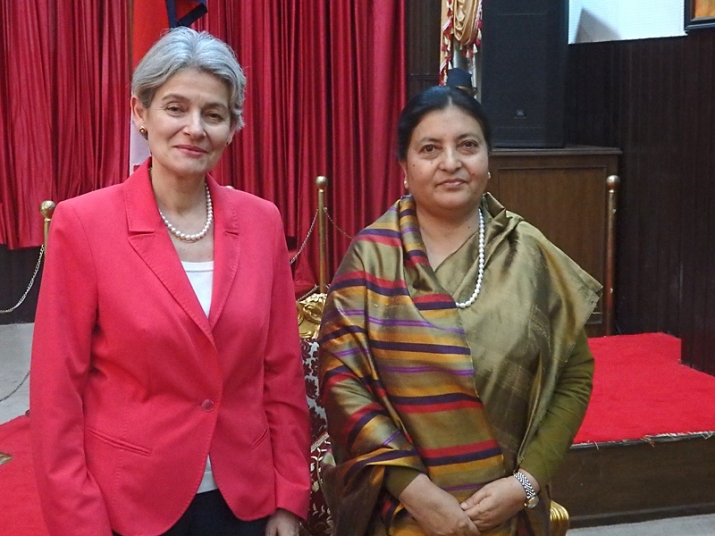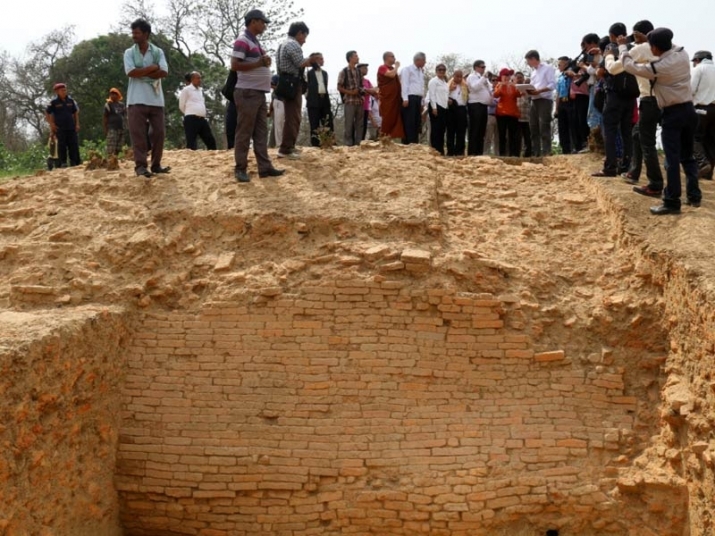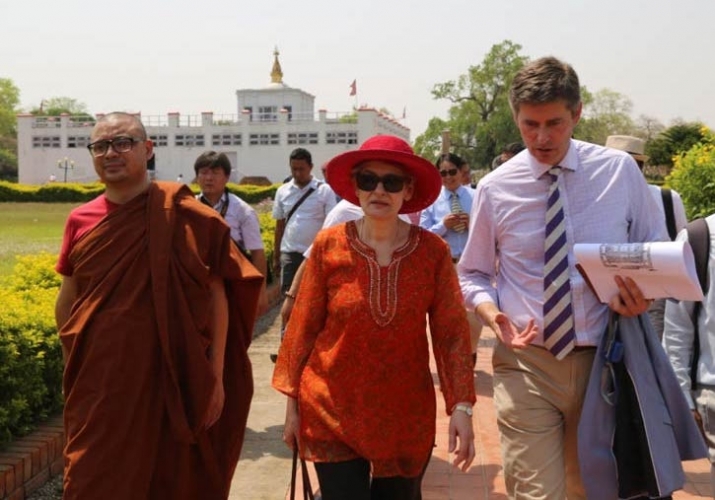NEWS
UNESCO Head Commends International Conservation Effort in Lumbini
 UNESCO Director-General Irina Bokova, left, with the president of Nepal, Bidya Devi Bhandar, in Kathmandu last week. Photo by Cynthia Guttman. From unesco.org
UNESCO Director-General Irina Bokova, left, with the president of Nepal, Bidya Devi Bhandar, in Kathmandu last week. Photo by Cynthia Guttman. From unesco.orgUNESCO Director-General Irina Bokova last week visited Lumbini in southern Nepal, where she commended the work being carried out by an international initiative to conserve and develop the birthplace of the historical Buddha, a UNESCO World Heritage Site since 1997.
Siddhartha Gautama was born in the gardens of Lumbini, which later became a place of pilgrimage for Buddhists from around the world. Among the pilgrims to subsequently visit the site, the Mauryan emperor Ashoka (r. c. 268–c. 232 BCE), who was a key figure in the propagation of Buddhism across Asia, erected a commemorative pillar there in 249 BCE. The site is being developed as a Buddhist pilgrimage center, and is the subject of an international project funded by Japan and implemented by UNESCO to preserve the archaeological remains associated with the Buddha’s birth.
“I am deeply moved to be here, in this place of hope and wisdom, almost one year after the first of two earthquakes that destroyed many parts of this country,” Bokova said in Lumbini on 19 April. “I believe we find here a source of courage and dignity for all the people of Nepal.” (UNESCO)
Also present were members of the International Scientific Committee for the Conservation and Management of Lumbini—a panel of international experts in archaeology, conservation, the environment, heritage management, and urban planning, and representatives of Buddhist communities.
 Bokova visits the archaeological excavation at Tilaraukot. Photo by Hari Thapa. From unesco.org
Bokova visits the archaeological excavation at Tilaraukot. Photo by Hari Thapa. From unesco.orgBokova congratulated the government of Nepal and the Lumbini Development Trust for the successful implementation of the UNESCO/Japanese Funds-in-Trust project for Strengthening the Conservation and Management of Lumbini, which began in 2010. Now in its second phase, the project is focusing on Tilaurakot, some 15 miles west of Lumbini and believed to have been the seat of the ancient Sakya kingdom. The use of ground radar technology and geophysical surveys in Tilaurakot enabled the spectacular discovery in February of the remains of a vast 1,800-year-old palace complex, where the historical Buddha is believed to have lived as Prince Siddhartha Gautama until the age of 29, before leaving to begin his quest for enlightenment.
Teams of archaeologists headed by Prof. Robin Coningham, UNESCO chair in Archaeological Ethics and Practice in Cultural Heritage at Durham University, have since excavated the find, revealing the most complete example of an ancient city in South Asia. Surrounded by fortified walls and ramparts, the site includes gates, a central complex of rectangular brick structures, courtyards, a central pond, and stupas.
“It is a beautiful example of how archaeology can inform us about urban planning and one of the earliest creations of urban culture,” observed Prof. Coningham. (UNESCO)
Prof. Coningham accompanied Bokova as she viewed some of the conservation project’s achievements, including the preservation of three key monuments—the Marker Stone, believed to indicate the exact spot at which the historical Buddha was born, the Maya Devi nativity sculpture, dating to the 4th century CE, and the pillar erected by Ashoka bearing an inscription of Shakyamuni’s name.
 Bokova with Prof. Robin Coningham during the visit to Lumbini's Maya Devi Temple. Photo by Hari Thapa. From unesco.org
Bokova with Prof. Robin Coningham during the visit to Lumbini's Maya Devi Temple. Photo by Hari Thapa. From unesco.orgBokova also toured the Maya Devi Temple, the main temple at Lumbini, which contains timber structures said to date back to the lifetime of the historical Buddha, discovered in 2013 beneath the brick remains of a Mauryan temple (the Mauryan empire ruled much of the Indian subcontinent from 322–185 BCE). Work is currently being carried out to adjust the water table in the area to prevent further degradation of the site during the summer monsoon season.
Bokova gave assurances that UNESCO would continue to work with international and domestic parties to continue conservation efforts in the area, in recognition of its unique historical and spiritual heritage. “There is no need to choose between the conservation of historical remains and the development of Lumbini,” she said. “Heritage can be a driver to learn new skills and knowledge, to develop new capacity and foster sustainable development, decent jobs and livelihoods. We can have all of this if we coordinate in harmony the initiatives by so many actors for whom this site carries special significance.” (UNESCO)
See more
On Buddha's Trail, from Lumbini to Tilaraukot (UNESCO)
Lumbini, the Birthplace of the Lord Buddha (UNESCO)
Strengthening Conservation and Management of Lumbini, the Birthplace of the Lord Buddha, World Heritage Property: A UNESCO/Japanese Funds-in-Trust Project, 2010-2013 (UNESCO)
Meeting of the International Scientific Committee: "Strengthening the Conservation and Management of Lumbini, the Birthplace of the Lord Buddha” (UNESCO)














